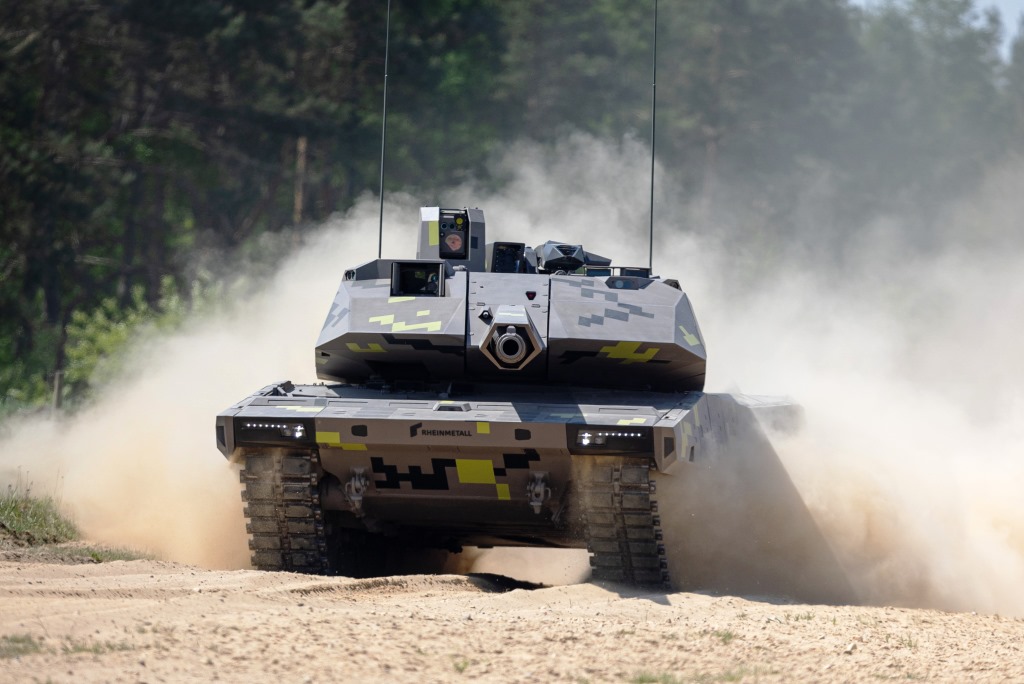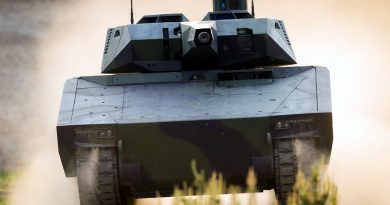
Panther/KF51, rethinking the MBT
“Lethality remains the raison d’être of an MBT and the 120 mm smoothbore gun system, including ammunition, has reached its limit, and due to the increased protection in recently developed Russian tanks a new solution had to be adopted,” Dr. Alexander Kuhrt, Vice President Next Generation Main Battle Tanks at Rheinmetall Landsysteme, stated loud and clear. The same is true on the protection side, especially now that loitering munitions (LMs) have become a dominant presence on the battlefield, together with other dive attack weapons; it is therefore mandatory to rethink survivability. The tank reconnaissance role must also be strengthened with the adoption of nowadays technology, Mr. Kuhrt underlined, mentioning the Carmel experiment in Israel as an example. Commandability is an issue that appeared recently, since networking allows to distribute all available information and data, something that will be further enhanced by artificial intelligence (AI), and designing current system in an AI oriented way is a must to fully exploit those new capabilities, Rheinmetall considering that in this area it can add extra combat value compared to existing systems, Mr. Kuhrt explained, adding.
The events of February 24th 2022 further increased the focus on heavy formations and MBTs in particular, however the Panther/KF51 design was initiated much earlier, between 2018 and 2019, the main gun development having started even earlier, in 2016, and since then it was designed for peer to peer conflicts and to protect the Atlantic Alliance on its eastern flank. Although designed for the new Cold War scenarios, Mr. Kuhrt underlines that the Rheinmetall MBT proposal can be upgraded to be used in other scenarios, such as asymmetric conflicts.

Born around its 130 mm gun and to operate in combined arms formations, the Panther electronic architecture is capable to act as a multi-domain hub, according to Rheinmetall, being the most protected element in the frontline. Cost was another key design parameter, the company aiming at providing an affordable solution to its potential customers, breaking the cost-increase trend. “We also offloaded supporting capabilities, for example air defence, potentially to unmanned ground vehicles that will form part of the combined arms team. A modular design based on pods was also adopted, to allow for example LMs to be used, possibly by a supporting tank not engaged on the front line,” Dr. Alexander Kuhrt continued, stressing also target handover capacities, supported by on-board micro-UAVs for close reconnaissance.

The Panther/KF51 uses a Leopard 2 running gear, powerpack and part of its hull structure. “That was a deliberate decision in order to have a straightforward migration path for all current Leopard users,” who will therefore profit of available spare parts on the market. “The running gear, which is mainly a mechanical design element, has been matured and optimised over 40 years, and considering that we manage to decrease the weight back to that of the A5 version we believe that both the running gear and the powerpack capabilities will be sufficient for the next 20 to 40 years.” Figures provided indicate a less than 59 tonnes combat weight, a range in excess of 500 km, a maximum forward speed of 70 km/h and a backward speed of 30 km/h, and an acceleration that brings the Panther from 0 to 40 km/h in 8 seconds. As for obstacle crossing, the Panther /KF51 is able to cope with a 60% slope and a 30% side slope, overcome a 2.5 meters wide trench and a 1.1 meters high step, and ford unprepared a 1.2 meters deep water gap. As for the size, the KF51 fits the tunnel profile according to the AmovP-4l standards contained in the NATO document on Technical Aspects of the Transport of Military Materials by Railroad.

Detailing the crew station, the 23-inch main screen is linked directly to the front-facing camera of the 360° vision suite, thus it is known as ‘virtual windscreen’, but it can obviously be fed with the images from other sensors, such as the commander sight, the gunner sight, and can use picture-in-picture options. It can also be used to plan or monitor an action, calling in the battle management system layer. The two 10-inch screens under the main one allow having at any time three different views in front of each crew member, but can also act as backup should the main display fail. Two more horizontal screens are available, at the same height of the main one, that reproduce the images generated by left and right 360° side cameras of the turret, providing increased situational awareness while remaining under armour protection.

Theoretically all crew members can play all roles aboard, the concept being that everything can be done from every seat. The driving position is obviously dedicated to that role, however in case of need the commander and gunner have the option to select the driving mode and drive the tank with their control handles, and in theory the driver can fire the gun, as al crew stations are very similar.
Although the primary viewing assets are the displays, Rheinmetall gave the option to all crew members to keep optic periscopes, so that if the power goes completely off they can still look outside. According to the company, first feedback are pretty positive, drivers never using the optical system fully relying on the virtual image provided on the screen.
“For Panther as it stands we have selected what we believe is a good mixture of innovative and key enabling technologies that goes along with proved and mature systems and capabilities we already have in the company, to make sure we have a fieldable system in a very short timeframe, while maintaining a growth capability for the next decades,” Dr. Alexander Kuhrt said.
Being the Panther/KF51 a digital system, Rheinmetall used simulation in the design process and by doing so it is inherently developing a simulator as it goes forward, so when the system design will be frozen the simulator will be available, as well as training concepts,” Mr. Kuhrt explained, adding that “having common crew stations will make it easier to generate, build and maintain simulators, compared to current simulators that are mechanical replicas of the systems, although some mechanical elements will be required,” this being already done with the Lynx launch customer.
The same applies to the enhanced condition monitoring, the fully digital platform making engine, sensors, runtime, default testing data available, that are fed into a central data base connected to customers’ logistic systems, the fleet support system being currently at prototype stage for an existing customer. The same will be done for the Panther /KF51.
Looking at the Panther project, Dr. Kuhrt stated that in some areas things are less clear than in others, and specifically this happens where the final customer has a greater influence, such as BMS integration, radio integration, adding or not an RCWS, and so on. These are the areas where commonality with the customers fleet come into play, “and these are the areas where we designed the system to be modular and able to comply with customers requirements.”
The Rheinmetall Landsysteme Vice President Next Generation Main Battle also said that the company is in discussion with a number of countries to determine specific Panther configurations “so the situation should become more clear in the coming months,” adding that a potential launch customer “will be on this continent.” Considering the numerous nations using the Leopard 2 it was said that there is an upgrade path from Leopard to Panther because of commonalities in certain areas in the chassis, although EDR On-Line understood that of course the aim is to produce new platforms. Rtheinmetall considers there is a market of 500 to 800 units within 2035, and between 5,000 and 8,000 units after 2035. “We are reasonably confident over the near term and this is backed up by the studies that independent agencies conduct on yearly basis on upgrade and replacement programmes in Europe,” he added. Closing remarks were referred to the MGCS: “We don’t necessarily see the Panther as an MGCS competitor, we consider that for some countries it is a bridging technology, as it contains technologies that we are also putting forward for the MGCS. Among those we propose the Future Gun System as well as some elements in the protection area and some automation bricks. But we certainly see a market beside the MGCS.”
Photos courtesy Rheinmetall and P. Valpolini


